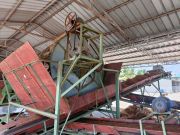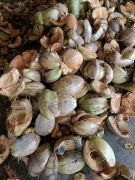The Environmental Benefits of Coir in Peat-Free Gardening
We are all growing more aware of the necessity to replace peat moss in our growing media with materials that are sustainably sourced and eco-friendly.
It can no longer be avoided that peat is not an ongoing solution for compost products where alternatives are being trialled that are proving to be just as effective. To protect natural peatlands and reduce the carbon output of our industry, alternatives must be sought.
This is where the debate turns more difficult. Which of the alternatives on the market is best suited to replace peat as the best growing media?
Coconut coir
One of the most commonly used alternatives on the market is coconut coir, made from the outer husks of the coconut. Coir is able to replicate many of the positive features that have made peat one of the best growing media substrates since its introduction to gardens in the mid-twentieth century, in particular the texture and moisture-holding capabilities of peat moss.
Coir fibres can absorb up to ten times their weight in water, making coir a fantastic option for most growers, particularly hydroponics specialists. Coupled with its friable texture that allows for fantastic root support, it is no wonder that coir is making waves in the growing media scene.
For the environmentally conscious gardener, coir is the best alternative on the market due not only to its renewability leaving our natural peatlands alone to thrive, but when harvested sustainably and manufactured as a natural by-material of the coconut, it provides us with a material that can be accessed easily with less damage to our environment and even recycled for new growing projects.
Coconut husk and pith are natural by-products of the coconut industry and turning them into a usable, effective growing media grants what would be ‘waste’ products with new life. Carving out peat from our natural landscapes releases carbon into the environment and cannot be easily replaced, whereas coconuts can be harvested year after year, making for a far more sustainable resource.
The quality of the coconut coir matters
The quality of the coconut coir matters when looking for effective results and fair judgement of the growing media as a whole. A commonly heard complaint is that some professionals who have tried a coir-based compost have had a less than positive experience with their growing results. This is typically not due to the coir itself, but the quality of the overall product.
Coir is a 100% natural material with no harmful additives, but as coconuts are predominantly grown in coconut trees adjacent to salt water near coastlines, there can be a higher than desired salinity content within the freshly-ground husk and pith.
Responsible coir manufacturers will efficiently wash the coir to ensure that not only is its unique texture preserved, but so that only trace salts remain to allow for a material that can be grown in that is fully inert. If a coir growing media product fails to deliver on results, it has more than likely not been washed to the standards required of most plants.
The manufacturing process of coir can also be completed with our environment in mind to further improve coir’s eco benefits over peat-based alternatives. An example of a company actively working on this would be Southern Trident, certified carbon neutral, who are constantly sourcing ways of offsetting carbon emissions produced in the manufacturing and transportation of their coir-based products – such as their support of a Verified Carbon Standard-certified program upgrading a composting facility in Delhi to produce compost for local soil that is low in organic carbon.
Reducing the amount of water used
They are also actively measuring the amount of water used in the washing process. Reducing the amount of water used in the manufacturing and washing processes cuts back on the amount of electricity required and reduction of potable, clean freshwater taken from the local environment.
Water used in the process can be easily recycled and sourced from more sustainable places such as local lagoons to ensure coir is not only thoroughly washed of most salts, but is overall a more eco-friendly end product.
Carbon footprint
Questions have been raised in the past about the carbon output when transporting a product from factories in India to the UK. Some consider peat to be the winner here with a shorter distance travelled by peat harvested in the UK and Europe.
However, it is possible to measure and offset the carbon emissions created in the shipping process from products created further afield – just as coir-producing companies are now beginning to do.
21% less carbon
Coir per cubic metre – when transported in its dried, compressed block form – emits 21% less carbon when shipped from Southern India to Liverpool by modern cargo ship than a cubic metre of composted bark from the forests of Scotland, for example, to Liverpool.
Southern Trident have begun to lead the way to show the ways in which growing media companies can switch not only to a peat-free alternative, but also the ways in which carbon can be offset in the manufacturing process to be a truly eco-friendly product.
Approved certification standards
Look for carbon neutral PAS 2060 certification on manufacturers’ websites from reputable, industry-recognised companies to be certain that the products you buy have been thoroughly vetted for the end-to-end production’s carbon emission measurement and the offsetting undertaken by the company.
When searching for your next growing medium that it is not just the manufacturing process itself that should be considered and improved upon for a well-rounded, environmentally conscious product. Ensuring that processes are ethically sound and meet approved certification standards are key for a product to be considered fully eco-friendly and responsibly sourced.
Compliance with clear policies and recommendations outlined such as those from SEDEX – one of the leading world’s ethical trade organisations – will show a company is dedicated not only to a cleaner, greener planet, but that it is also committed to sustaining a better quality of life, giving back to the local communities in which staff and their families live.
Coir can be the sustainable growing media of our future.
The more we return to our planet and communities, the more we as an industry will see the longevity of the horticultural hobby – starting with switching from environmentally damaging source materials.
Coir is undoubtedly one of the forerunners when it comes to the race to replace peat moss. Considering the methods of sustainable farming, recycling of waste material, water usage reduction, ethical practices followed, and carbon offsetting that can be seen in its production by reputable manufacturers, there is no denying that coir can be the sustainable growing media of our future.


